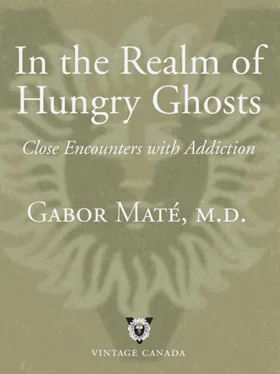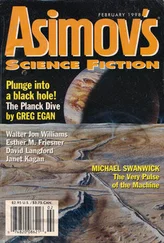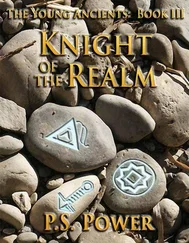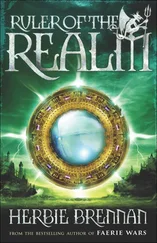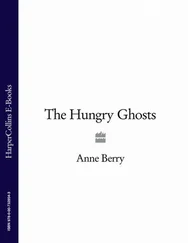Anatomically, physical pain is registered in one part of the brain, the thalamus, but its subjective impact is experienced in another part, the anterior cingulate cortex, or ACC. The brain gets the pain message in the thalamus, but “feels” it in the ACC. This latter area “lights up,” or is activated, when we are reacting to the pain stimulus. And it’s in the cortex—the ACC and elsewhere—that opiates help us endure pain by reducing not its physical but its emotional impact.
A recent imaging study showed that the ACC also “lights up” when people feel the pain of social rejection. 11The brains of healthy adult volunteers were scanned as they were mentally participating in a game and then suddenly “excluded.” Even this mild and obviously artificial “rejection” lit up the ACC and caused feelings of hurt. In other words, we “feel” physical and emotional pain in the same part of the brain—and that, in turn, is crucial to our bonding with others who are important to us. In normal circumstances, the emotional pain of separation keeps us close to each other when we most need that closeness.
Why did Nature make the mammalian opioid system responsible for our reactions to both physical and emotional pain? For a very good reason: the complete helplessness of the young mammal and its absolute dependence on nurturing adults. Physical pain is a danger alarm: if a child wakes up with a tummy ache, her ACC goes into overdrive and she’ll give every possible signal to call her caregivers promptly to her side. For the infant mammal, emotional pain is an equally essential warning: it alerts us to the danger of separation from those we depend on for our very lives. Feeling this emotional pain triggers infant behaviours—ultrasonic vocalization in rat pups, pitiful crying in human babies—designed to bring the parent back. The attentive presence of the nurturing adult will trigger endorphin release in the infant’s brain, helping to soothe her.
A child can also feel emotional distress when their parent is physically present but emotionally unavailable. Even adults know that kind of pain when someone important to us is bodily present but psychologically absent. This is the state the seminal researcher and psychologist Allan Schore has called “proximal separation.” 12Given that the child’s dependence is as much emotional as physical, in normal circumstances a child who senses emotional separation will seek to reconnect with the parent. Once more, the parent’s loving response will flood the brain with endorphins and ease the child’s discomfort. Should the parent not respond, or not respond adequately, endorphins won’t be released, and the child will be left to his own inadequate coping mechanisms—for example, rocking or thumb-sucking as ways of self-soothing or tuning out to escape his distress. Children who have not received the attentive presence of the parent are, as we will see, at greater risk for seeking chemical satisfaction from external sources later in life.
In keeping with Nature’s efficient, multipurpose “recycling” of chemical substances, endorphins are also responsible for experiences of pleasure and joyful excitement. Like infants and mothers, lovers, spiritual seekers and bungee jumpers—yes, bungee jumpers—all reach euphoric states in which endorphins play a key role. One study found that endorphin levels tripled in the blood of bungee jumpers for the half-hour following the leap and were correlated with the degree of reported euphoria: the higher the endorphin levels, the greater the euphoric feelings. 13
While the brain’s opiate receptors are the natural template for feelings of reward, soothing and connectedness, they are also triggered by narcotic drugs, and they play a role in other addictions, too. In a study of alcoholics, opioid receptor activity was diminished in several brain regions, and this was associated with increased alcohol craving. 14The activation of opioid pathways and the resulting increased endorphin activity also enhances cocaine’s effects. 15As with alcohol, less endorphin activity means a greater desire for cocaine. Activation of opiate receptors contributes to the pleasures of marijuana use as well. 16
In short, the life-foundational opioid love/pleasure/pain relief apparatus provides the entry point for narcotic substances into our brains. The less effective our own internal chemical happiness system is, the more driven we are to seek joy or relief through drug-taking or through other compulsions we perceive as rewarding.
The very essence of the opiate high was expressed by a twenty-seven-year-old sex trade worker. She had HIV and has since died. “The first time I did heroin,” she said to me, “it felt like a warm soft hug.” In that phrase she told her life story and summed up the psychological and chemical cravings of all substance-dependent addicts.
CHAPTER 15

Cocaine, Dopamine and Candy Bars: The Incentive System in Addiction
Lisa stands in the middle of my office and lifts her blouse to show the scattered red rash covering her abdomen, chest and back. Her body jerks around like a rigid puppet. In the crook of her right elbow she cradles a giant plastic bottle of orange drink as she would a baby or a doll. With her left hand she pulls at her hair. Although she’s twenty-four years old, Lisa is so emotionally immature and physically childlike that often when I see her I think she belongs at home playing with dolls rather than here in the Downtown Eastside. Today her restless movements make her look even more childlike than usual. Her short stature, large eyes and puffy cheeks smeared with mascara and dried tears give her the look of an adolescent girl caught playing with her mother’s makeup. She’s high on cocaine.
“I’ve had this rash for three days. What is it, Doc?”
I ask her to sit so I can inspect her hands and feet. She pulls off her dirty white socks. The little red dots are visible on her palms and soles, as well.
“I’m afraid it’s syphilis,” I tell her. “You’ll need a blood test.”
In twenty years of family practice I never saw one case of syphilis; here in the Downtown East Side, it’s diagnosed regularly.
As Lisa leaps to her feet, the plastic bottle clatters to the floor, spilling its contents. “How can it be syphilis?” she exclaims in a voice that mixes childish surprise with complaint. “I thought that was a sexual disease.”
“It is.”
“But can you get it when the guy just comes on your pussy?” For a moment her naïveté leaves me at a loss for words.
“Who was your partner?” I ask. “He ought to be tested as well.”
“How should I know, Doc? It was in an alley. I was looking for coke money. It was the day before Welfare Wednesday and I couldn’t wait anymore.”

Many addicts have told me that cocaine is a tougher taskmaster than heroin, harder to escape. Although it doesn’t cause physical withdrawal symptoms nearly as distressing, the psychological drive to use it seems more difficult to resist—even after it no longer gives much pleasure.
Cocaine increases brain levels of the neurotransmitter dopamine by blocking it from being transported back into the nerve cells that release it. (Recall that all drugs work by locking into receptor sites on cell surfaces.) Cocaine’s effects wear off very quickly because it occupies its receptor sites for only a brief time. The urge to use, to get the next dopamine hit, then redoubles. Like other stimulant drugs—speed, nicotine and caffeine—cocaine taps directly into a brain system that, in its own way, is just as powerful as the opioid attachment/reward system described in the previous chapter. It plays a key role in all substance addictions and also in behavioural addictions.
Читать дальше
